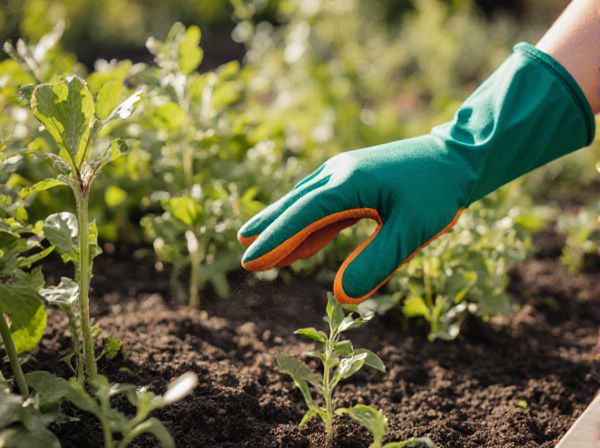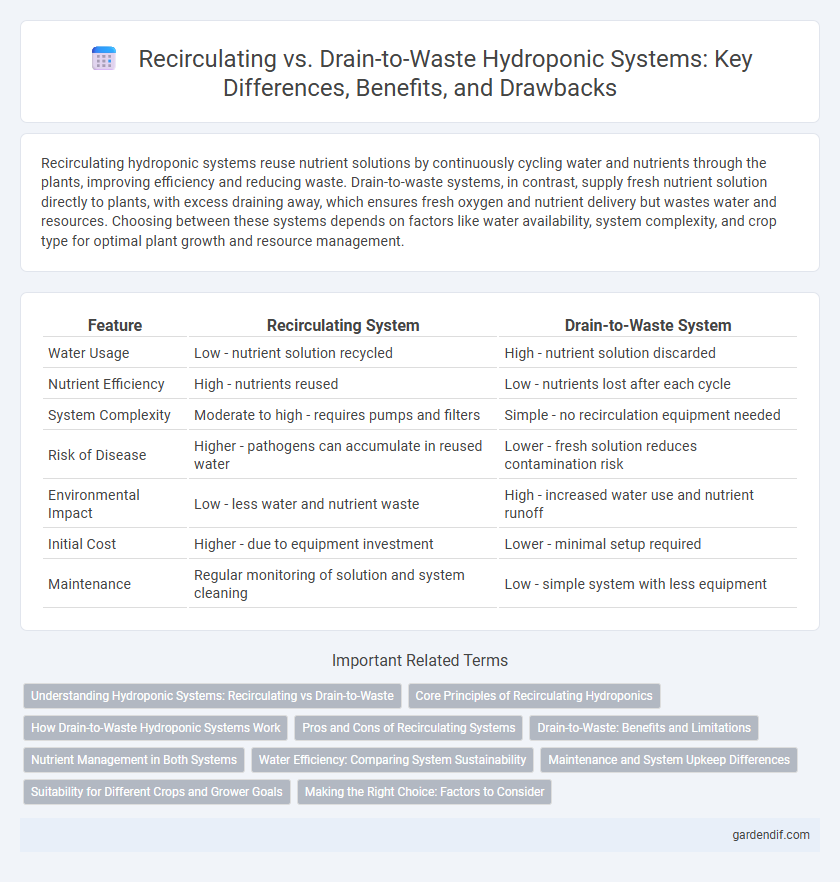
Recirculating System vs Drain-to-Waste System Illustration
Recirculating hydroponic systems reuse nutrient solutions by continuously cycling water and nutrients through the plants, improving efficiency and reducing waste. Drain-to-waste systems, in contrast, supply fresh nutrient solution directly to plants, with excess draining away, which ensures fresh oxygen and nutrient delivery but wastes water and resources. Choosing between these systems depends on factors like water availability, system complexity, and crop type for optimal plant growth and resource management.
Table of Comparison
| Feature | Recirculating System | Drain-to-Waste System |
|---|---|---|
| Water Usage | Low - nutrient solution recycled | High - nutrient solution discarded |
| Nutrient Efficiency | High - nutrients reused | Low - nutrients lost after each cycle |
| System Complexity | Moderate to high - requires pumps and filters | Simple - no recirculation equipment needed |
| Risk of Disease | Higher - pathogens can accumulate in reused water | Lower - fresh solution reduces contamination risk |
| Environmental Impact | Low - less water and nutrient waste | High - increased water use and nutrient runoff |
| Initial Cost | Higher - due to equipment investment | Lower - minimal setup required |
| Maintenance | Regular monitoring of solution and system cleaning | Low - simple system with less equipment |
Understanding Hydroponic Systems: Recirculating vs Drain-to-Waste
Recirculating hydroponic systems continuously reuse nutrient solutions by filtering and returning them to the plants, optimizing water and nutrient efficiency while reducing waste. Drain-to-waste systems supply fresh nutrient solutions to plants with excess drainage discarded, minimizing the risk of pathogen buildup but increasing water consumption. Choosing between these systems depends on balancing resource conservation against disease management and operational complexity.
Core Principles of Recirculating Hydroponics
Recirculating hydroponic systems maintain nutrient solutions by continuously cycling water through plant roots, maximizing resource efficiency and reducing waste. These systems rely on precise monitoring of pH, electrical conductivity (EC), and oxygen levels to optimize nutrient uptake and plant growth. Unlike drain-to-waste systems, recirculating setups promote sustainability by conserving water and nutrients through reuse within a closed environment.
How Drain-to-Waste Hydroponic Systems Work
Drain-to-waste hydroponic systems deliver nutrient solution directly to the plant roots, with excess solution draining away and not reused. This system minimizes the risk of pathogen buildup by preventing recirculation but requires a continuous supply of fresh nutrient solution, leading to higher water and nutrient consumption. It is commonly favored for its simplicity and reduced maintenance compared to recirculating systems.
Pros and Cons of Recirculating Systems
Recirculating hydroponic systems efficiently reuse nutrient solutions, reducing water and fertilizer consumption by up to 90%, making them highly sustainable for commercial growers. They require careful monitoring to prevent pathogen buildup and nutrient imbalances, which can impact plant health and yield. Despite higher initial setup costs and complex maintenance, recirculating systems offer enhanced resource efficiency and environmental benefits compared to drain-to-waste methods.
Drain-to-Waste: Benefits and Limitations
A Drain-to-Waste hydroponic system offers precise nutrient control by discarding excess solution after each cycle, reducing the risk of nutrient imbalances and pathogen buildup. This method minimizes salt accumulation and eliminates the need for complex filtration or recirculation equipment, making it simpler and ideal for beginners or small-scale growers. However, it generates higher water and nutrient consumption compared to recirculating systems, leading to increased operational costs and environmental concerns in large-scale production.
Nutrient Management in Both Systems
Recirculating hydroponic systems optimize nutrient management by continuously cycling nutrient solutions, allowing precise control and reuse, which reduces waste and maintains consistent nutrient levels for plant uptake. Drain-to-waste systems apply fresh nutrient solutions to plants once, resulting in nutrient runoff and higher resource consumption but simplify nutrient composition monitoring with minimal buildup risks. Effective nutrient management in recirculating systems demands regular solution monitoring and adjustment to prevent salt accumulation, whereas drain-to-waste systems require careful nutrient formulation to ensure optimal plant nutrition per application.
Water Efficiency: Comparing System Sustainability
Recirculating hydroponic systems recycle nutrient solution, significantly reducing water consumption by continuously reusing water, which boosts water efficiency and minimizes waste. Drain-to-waste systems discharge excess nutrient solution after each cycle, resulting in higher water usage and increased environmental impact due to nutrient runoff. Recirculating systems offer superior sustainability by conserving water resources and lowering the risk of water pollution compared to drain-to-waste systems.
Maintenance and System Upkeep Differences
Recirculating hydroponic systems require regular monitoring and maintenance of nutrient solution quality, including pH and electrical conductivity, to prevent pathogen buildup and ensure optimal plant growth. Drain-to-waste systems simplify upkeep by discarding excess nutrient solution, reducing the risk of disease but increasing nutrient consumption and water waste. Routine cleaning of pumps, reservoirs, and tubing is essential in recirculating systems to avoid clogging, while drain-to-waste setups typically need less frequent but thorough sanitation to prevent residue accumulation.
Suitability for Different Crops and Grower Goals
Recirculating hydroponic systems are ideal for leafy greens, herbs, and microgreens, providing nutrient efficiency and water conservation suited for growers aiming at sustainability and cost-effectiveness. Drain-to-waste systems suit fruiting crops like tomatoes and peppers, allowing precise nutrient control and minimizing disease risk, preferred by growers targeting high yields and crop quality. Crop type and production objectives determine the optimal choice between resource-efficient recirculation and targeted nutrient delivery in hydroponic setups.
Making the Right Choice: Factors to Consider
Choosing between a recirculating system and a drain-to-waste system in hydroponics depends on factors such as water conservation, nutrient management, and crop type. Recirculating systems excel in water efficiency by recycling nutrient solutions, making them ideal for large-scale or resource-sensitive operations, while drain-to-waste systems provide simpler nutrient control and reduce disease risk, suitable for small-scale or diverse crop production. Evaluating environmental impact, operational complexity, and crop requirements ensures an informed decision tailored to specific hydroponic goals.
Recirculating System vs Drain-to-Waste System Infographic

 gardendif.com
gardendif.com